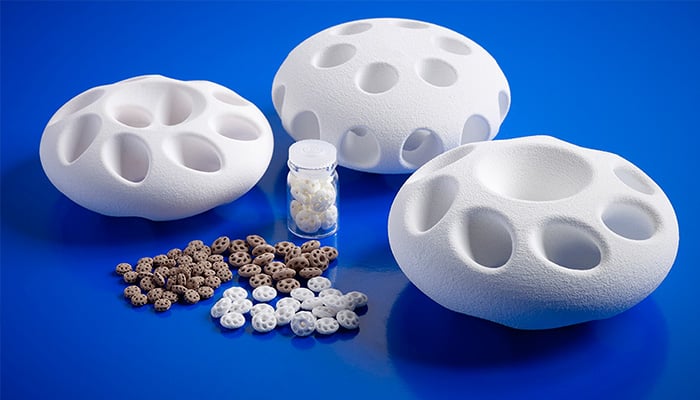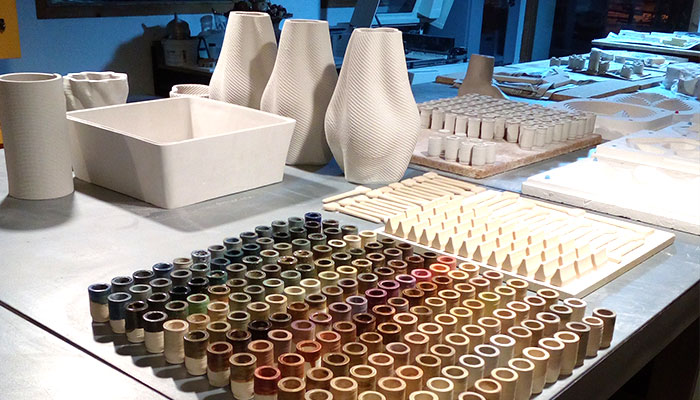Ceramics have been a hot trend in 3D printing materials for a while now. While more commonly associated with pottery or kitchenware, ceramic is literally everywhere in our daily lives, and it’s used extensively in various industries.
Producing complex parts with ceramics is challenging and costly with 3D printing. This is why so much has been invested in new printing techniques. While the familiar printing method FDM is a common process for clay and other paste-like ceramics, more accurate processes like SLA and binder jetting have also been adapted to produce more precise ceramic parts.

What is ceramic 3D printing?
Today, ceramic 3D printers are mostly expensive industrial additive manufacturing systems. These systems vary in the 3D printing technologies they use to 3D print ceramic material: extrusion, binder jetting, photopolymerization, and powder sintering.
However, 3D printing is only part of a longer manufacturing process. Ceramic 3D printers generate green parts, meaning that they must go through heavy post-processing steps in order to reach their final form. One of these steps, for instance, is firing the ceramic part or prototype in a high-temperature kiln.

Terms you should know first
Here are some terms that can help you to better understand 3D printing with ceramic materials:
- Green object: A clay object that still needs to be sintered (or fired up) in a kiln.
- Kiln: The oven used for post-processing (sintering) the green object.
- Firing: in some cases, this step must be repeated more than once.
- Glazing (optional): professionals may choose to cover the object with glaze to give it a special color or finish, such as matte or glossy.
- Sintering: The process of partially melting clay particles to obtain hard ceramics objects.
- Binder jetting: The 3D printing technology that works by gluing together powder particles to form the object’s slices.
- Material extrusion: 3D printing technology that’s similar to fused deposition modeling (FDM), where a plastic filament is heated up and extruded through a nozzle to form a layer-by-layer 3D object. In ceramic 3D printing, the material is extruded in a paste state to form a green object.
- Clay: A fine-grained natural soil material that combines one or more minerals with traces of metal oxides and organic matter.
- Ceramic: An inorganic solid material comprising of metal, non-metal, or metalloid atoms, usually made from clay sintered in a kiln.
- Porcelain: A durable and heat-resistant material made by heating materials, generally including kaolin, in a kiln to temperatures between 1,200 and 1,400 °C (2,200 and 2,600 °F).

Which technologies can realize ceramic 3D printing?
There are several 3D printing technologies available to 3D print ceramic material:
- Paste extrusion: a paste extruder deposits layers of ceramic onto a build plate.
- Powder sintering: the ceramic is in a powdered form and is sintered layer by layer.
- Binder jetting: the 3D printer deposits layers of the binding agent upon layers of powder.
- Photopolymerization: a light source solidifies a mix of resin and ceramic powder layer after layer.
Stereolithography (SLA)
Digital light processing (DLP)
Other technologies also date back to the advent of additive manufacturing technologies such as stereolithography, although it was not until years later that ceramic materials were incorporated. One of the great pioneers in the ceramic additive manufacturing industry is the French company 3DCeram.
“It was in 2005 that Christophe Chaput decided to investigate the possibility of additive manufacturing combined with ceramics. He started printing biomedical parts, skull implants… In 2009, he and I bought the company Cerampilot and decided to change the name to 3DCeram and change its business model, i.e. to manufacture parts only through 3D printing“, commented Richard Gaignon, CEO of 3DCeram, after asking him about the origins of its developments. From 2014, the French company integrated DLP technology by incorporating a UV laser into its machines. They now have a wide range of 3D printers such as the C900, a hybrid press that can print more than one material at the same time, dedicated to the electronics and energy industry. Plus two additional machines launched this year: The C100 a machine “KISS” (Keep It Smart and Simple) according to the manufacturer and its C3600 specialized in technical ceramics.
Ceramic binder jetting (CBJ)
Binder Jetting is one of the technologies that began to manufacture with ceramic powders. The beginnings of the technology go back to the 90s: starting with an MIT project, then acquired by Z Corporation, and after a few years of development bought by 3D Systems. The technique consists of manufacturing ceramic powders using a binder that solidifies in a cross-section on a powder bed. This results in full colour models, although not very resistant for some industrial purposes.
Applications for ceramic 3D printing
In general, ceramic materials provide a number of properties:
- High strength and dimensional stability
- Low density
- Chemical stability
- High electrical insulating capacity
- High resistance to abrasion and corrosion
Therefore, ceramic 3D printing suits a wide variety of applications.
These applications include engineering in industries such as aerospace, automotive, chemical, electrical, environmental, medical, and more. Of course, artists can also benefit from ceramic 3D printing for pottery and sculptures. Here, we are highlighting two industries where ceramic 3D printing seems to be gaining prominence:
- Ceramic art, pottery, and sculptures: For hundreds of years, we have been using clay to create beautiful and/or functional objects. Dutch designer Oliver van Herpt, for example, uses his ceramic 3D printer to create impressive vases. Ceramic material is also used in the luxury industry for watches and jewelry.
- Biomedical: There are a number of applications with 3D printing ceramics when it comes to the medical industry. For instance, patients can benefit from custom implants made of calcium phosphates, a material that is very close to human bone composition. Furthermore, it’s possible to control the implant’s porosity.
This means 3D printed bone substitutes will have a low chance of rejection from a body’s immune system.
The arrival of ceramic 3D printing in different industries
The introduction of technical ceramic materials in different industries will bring long-term benefits to the market. Many companies are started thanks to the ceramic 3D printing services that exist today. Major players in this field such as Materialise or Shapeways offer different manufacturing possibilities for these companies. The manufacturers themselves also offer 3D printing services such as 3DCerams or Admatec. However, traditional ceramic companies are also opting for additive manufacturing.

If you’re toying with the idea of creating a custom-made print, but you don’t have the equipment to pull it off, or if you’d rather a professional printer take care of business on your behalf, try FacFox, your one-stop 3D printing service partner. At the moment, Craftcloud deals with most 3D printing techniques, and it’s currently in the process of branching out into the world of ceramics.
